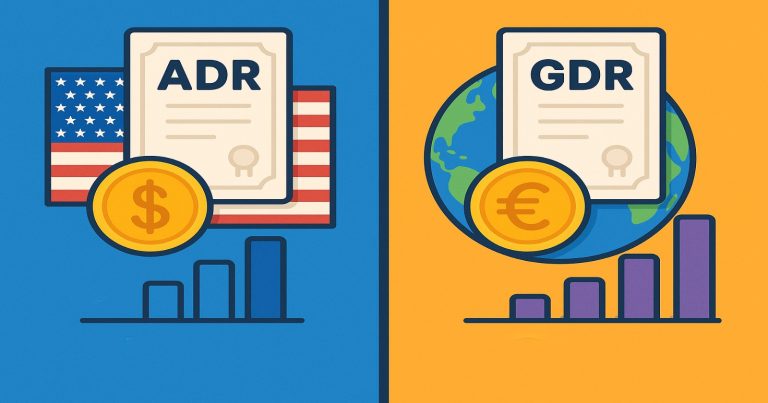ADR and GDR are financial instruments that provide companies the opportunity to obtain funding from an international source. An ADR is essentially a US-listed security, as investors can invest in foreign companies on the exchanges of America. On the other hand, GDRs are mainly used in European and Asian markets allowing companies to access capital outside their ‘home’ country. The knowledge and ability to distinguish ADRs from GDRs are important for investors wishing to diversify internationally and to companies looking to broaden their capital base.
Key Differences Between ADR and GDR
ADRs and GDRs are very important to companies that look forward to raising international capital. Although they share the same objectives, they have a lot of differences from a target perspective, regulatory framework, and investor access. This section narrows down the ten major differences that demarcate the two mechanisms and summarizes them in an orderly table and explanations.
1. Market of Trade
- ADR: The ADRs trade only in the United States. It enables companies abroad to list their shares at American exchanges, like NYSE or NASDAQ, which makes it easier for domestic US investors to invest in these companies without having to access foreign exchanges.
- GDRs: GDRs are more oriented toward trading in overseas markets, particularly in Europe and Asia. The primary listing exchanges among the GDRs are the London Stock Exchange and the Luxembourg Stock Exchange, thereby allowing GDRs to tap into investments from various countries.
2. Issuing Bank
- ADR: Generally, U.S. banks, such as J.P. Morgan or Citibank, hold shares in the foreign company and issue receipts representing ownership in the U.S. market.
- GDR: GDRs can be issued by any international bank or bank based outside the U.S., such as Deutsche Bank and HSBC, which manages shares on behalf of the issuing company.
3. Currency
- ADR: ADRs are denominated in U.S. Dollars (USD), which simplifies the transaction process for American investors, as they avoid dealing with foreign currency fluctuations or conversion fees.
- GDR: GDRs can be denominated in multiple currencies, including USD, Euros, or even other local currencies, providing flexibility for investors from different countries to trade in familiar currency denominations.
4. Target Investors
- ADR: ADRs primarily cater to American investors looking for an easy way to invest in foreign companies without dealing with the complexities of foreign stock exchanges and currencies.
- GDR: GDRs target a broader range of global investors, including those in Europe, Asia, and other regions outside the issuing company’s home country. This makes GDRs an attractive option for companies seeking wider international exposure.
5. Regulatory Body
- ADR: Since ADRs are traded on U.S. exchanges, they are regulated by the U.S. Securities and Exchange Commission (SEC). This means they must comply with U.S. financial reporting, disclosure standards, and regulatory guidelines, providing a level of transparency familiar to American investors.
- GDR: GDRs are subject to the regulations of the foreign exchanges where they are listed, such as the London Stock Exchange’s rules or EU financial regulations. This regulatory framework differs from that of the U.S., which may impact the level of disclosure and compliance required.
6. Tax Implications
- ADR: Since ADRs are U.S.-listed, they fall under the purview of U.S. tax laws, including tax withholding on dividends for foreign securities. American investors need to understand these tax implications when investing in ADRs.
- GDR: GDRs are subject to the tax laws of the country where they are issued and where the investors reside. This can lead to varying tax consequences depending on international tax treaties and policies, which investors need to review before investing.
7. Ease of Access for Local Investors
- ADR: ADRs are accessible to any investor whose domicile and physical address is in the United States. Aninvestor based in the United States can purchase ADRs from any U.S. broker. There is no involvement of foreign currency exchanges or international trading accounts.
- GDR: GDRs allow international investors to access an issuer other than the issuer’s home country. They are not easily accessible to investors in some regions, such as the United States, where they are not listed unless an agreement has been set.
8. Types of Receipts
- ADR: ADR may be sponsored or unsponsored. Sponsored ADRs require cooperation between the foreign company and include voting rights and fairly detailed disclosures. Unsponsored ADRs are created solely by a U.S. bank and generally lack voting rights and have lesser information to the investor.
- GDRs: GDRs are generally issued under sponsorship. This is to mean that they are issued in collaboration with the foreign company and the depository bank. This, in turn ensures that investors obtain standard financial disclosures on a consistent basis, which helps keep on record transparency over international investments.
9. ADRs and GDRs Examples
- ADR: Infosys is the Indian IT major whose ADRs are listed in the NYSE. This helps an American investor invest in Infosys through the most convenient and familiar platform.
- GDR: Tata Motors is another giant Indian company which has GDRs in the London Stock Exchange. This facilitates investment in Tata Motors by European and other international investors, thereby expanding its investor base.
10. Role in Indian Financial Market
- ADR: ADRs help Indian companies raise capital in the U.S., benefiting from the large pool of American investors and the robust liquidity of U.S. stock exchanges. This is especially useful for companies aiming to expand their visibility and brand recognition in the American market.
- GDR: GDRs assist Indian companies in raising capital in European and Asian markets. They allow Indian businesses to diversify their investor base and gain access to a wider range of international funds, aiding in their global expansion and financial stability.
| Feature | ADR (American Depository Receipt) | GDR (Global Depository Receipt) |
|---|---|---|
| Market | Traded primarily in the U.S. | Traded internationally, mainly in Europe & Asia |
| Issuing Bank | U.S.-based banks | International banks |
| Currency | Denominated in U.S. Dollars | Can be in USD, Euros, or other currencies |
| Target Investors | Primarily U.S. investors | Global investors outside the issuing country |
| Regulatory Body | U.S. SEC | Foreign exchanges (LSE, Luxembourg) |
| Tax Implications | Subject to U.S. tax laws | Varies by issuing and investor country |
| Ease of Access | Easily accessible for U.S. investors | Accessible to global investors |
| Types | Sponsored and Unsponsored | Mostly Sponsored |
| Examples | Infosys ADR on NYSE | Tata Motors GDR on LSE |
| Role in Indian Market | Capital raising in U.S. markets | Capital raising in European and Asian markets |
American Depository Receipt Meaning
An ADR enables the shares of foreign companies to be listed on the U.S. stock exchanges. It benefits the American investors because they may invest in international companies without dealing with foreign exchange or currency. For instance, Infosys is an Indian IT company listed in NYSE through its ADRs, and U.S. investors can buy Infosys shares without needing any conversion of the currency or venturing into the Indian stock exchange.
Role of American Depository Receipts in India
It acts as a financial bridge for Indian firms that want to attract U.S. investors. In simpler terms, Indian companies like ICICI Bank and Tata Motors gain substantial visibility and capital in the U.S. market with ADR issuance. This would not only boost their financial muscles but also witness improvement in brand value across the globe.
Types of ADRs
ADRs are classified into two main categories:
- Sponsored ADRs: Under this kind of ADR, the foreign company and the U.S. depository bank work together directly to issue the ADR. Sponsored ADRs offer voting rights and full financial disclosure to the investor.
- Unsponsored ADRs: This ADR entails a U.S. bank issuing an ADR without involving the foreign company. The non-sponsored ADR lacks voting rights and offers limited information to investors, mostly leading to irregularities in the regulatory steps.
What is Global Depository Receipt?
Global Depository Receipts, in short, are negotiable instruments issued by a foreign company and represent its share. The major difference between ADRs is that they can only be traded in the United States while GDRs can be traded on multiple exchanges across Europe and Asia. They enable foreign investors to invest in international businesses where investing in foreign business often gives them legal and tax complications in terms of cross-border investments.
Role of Global Depository Receipts in India
GDRs enable Indian companies to raise finance from markets outside their domestic economy. The issuers of GDRs quote them on recognized foreign stock exchanges such as the London Stock Exchange or the Luxembourg Exchange, thus exposing the Indian business to the international investor market and allowing it access to a huge investor base that could appreciate and provide enhanced liquidity to the valuation of the securities.
Process of Issuing ADRs and GDRs
The issuance process for both ADRs and GDRs involves collaboration between the issuing company, a depository bank, and an investment bank.
- Company’s Approval: The company authorizes a depository bank to create depository receipts.
- Depository Bank Role: The depository bank holds the underlying shares of the foreign company and issues the ADRs or GDRs to investors.
- Trading and Settlement: ADRs are traded on U.S. exchanges, while GDRs are primarily traded in European or Asian markets, allowing investors to buy and sell them as regular stocks.
Criteria for Selecting ADRs and GDRs for Investment
Investors should evaluate several factors before investing in ADRs or GDRs:
- Currency Exchange Rate Stability: ADRs and GDRs expose investors to foreign currency risk, especially if they are unfamiliar with the company’s home country currency.
- Regulatory and Taxation Considerations: ADRs are governed by U.S. SEC regulations, while GDRs are subject to international rules. Understanding these regulations ensures smoother investment transactions.
- Company’s Financial Health: Analyzing the issuing company’s financial statements, revenue, profit margins, and growth potential is essential to minimize investment risks.
ADR and GDR FAQs
What is the difference between ADR and GDR in simple terms?
ADRs represent shares of foreign companies traded on U.S. exchanges, while GDRs are issued internationally, mostly in European and Asian markets.
How do American Depository Receipts benefit Indian companies?
ADRs help Indian companies raise capital in the U.S., enhancing their global brand visibility and financial position.
What types of companies issue Global Depository Receipts?
Companies seeking international expansion often issue GDRs, especially those in emerging markets like India, to attract foreign investors.
Are there tax benefits associated with ADR and GDR investments?
ADRs are subject to U.S. tax laws, while GDRs may be governed by international tax laws, offering varied tax implications based on the investor’s country.
What are the types of American Depository Receipts available?
ADRs come in two forms: sponsored, where the company is involved, and unsponsored, which are managed solely by U.S. banks.


